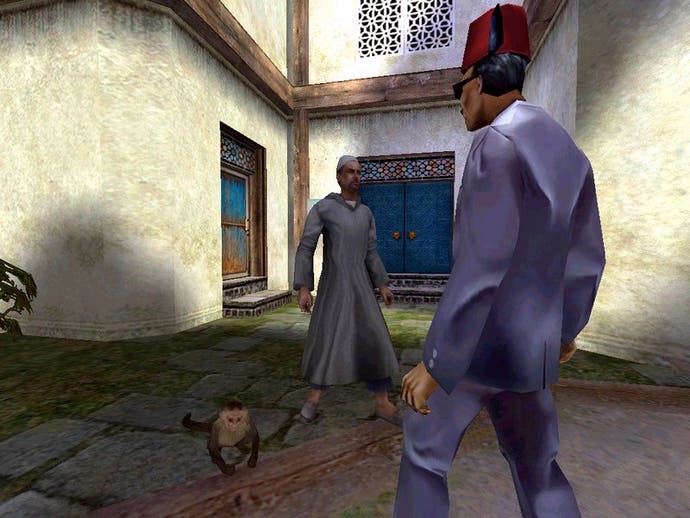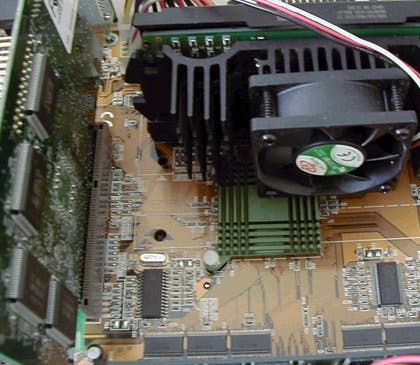Christmas Upgrades Part 1
Article - in part one of our buyer's guide for the festive season, we look at CPUs and graphics cards; what to buy, where to buy and how to install them
Christmas bonuses and hardware upgrades. If, like me, you group the two together in their own little spending bracket, then the chances are that amongst the things you will be picking up this Yuletide season are new parts for your beloved PC. However, unless you are overburdened with time you may not be aware of just what your options are this year, and that, dear reader, is one thing we can put right...

Plan Your Spending
The most obvious thing to do here is to first assess just what you need to do to your computer to get it up to scratch, and capable of doing Christmas stocking fillers like "Project IGI" and "No One Lives Forever" justice. Your options can be grouped in several ways, but we have decided to do it by type. This week we will take a look at the best CPU and graphics card upgrades that can be had for as little as possible, and where you would be best investing your hard earned money. Next week, we will consider which monitors, sound cards and storage devices you would be best chasing. So where should you invest? If your PC is getting on a bit you might like to consider a whole new rig - you can always donate the old machine to the wife or a young relative to keep them happy - but most likely a new motherboard, processor and graphics card will suffice. Whole systems are quite easy to pick up cheaply this year, because not many people are bothering to! Retailers are happy to shift new boxes, and at very reasonable prices. Firms like PC World, Dixons and Tempo all have good high street deals on offer, although you can find far cheaper deals on the internet, or amongst the reams of adverts in magazines like Computer Shopper. In our expert opinion, something of the Pentium III or Athlon variety at around the 600MHz mark with 128Mb of memory and a GeForce graphics card is a good target to aim at if you are on a budget. If you are shopping online, you might like to consider groups like Dell, whose UK site is very well equipped to help you buy exactly what you need. Note - Although AMD is launching its DDR-based systems very soon, and Intel's Pentium 4 is already available in limited quantites, we wouldn't recommend them. This is because the individual parts cost more than most whole systems put together, and they are both unproven in their effects. The Pentium 4 is receiving a real roasting from the online media, and many are even debating whether or not investing in a DDR Athlon system is worthwhile at the moment. These upgrade paths will be worth considering next Christmas, but in the meantime let's concentrate on what's realistic.
Processors
Processors are difficult animals, because you can't just stick any old CPU on your motherboard. It has to be either (a) directly compatible, or (b) compatible via an adapter of some sort. If you want some more megahertz to boast about, first whip off your PC's case and check what you have. Most likely you know that you have a "Celeron 500Mhz" or similar, but in order to upgrade you will also need to know what motherboard you have, or at the very least what type of CPU it takes. Here's a brief rundown to try and help you work out what you have... Intel Celeron <533MHz - Slot 1/PPGA Intel Celeron >533MHz - FCPGA Intel Pentium II - Slot 1 Intel Pentium III <550MHz - Slot 1 Intel Pentium III >550MHz - Slot 1/FCPGA AMD K6/K6-2 - PPGA AMD Athlon <700MHz - Slot A AMD Athlon >700MHz - Slot A/Socket A AMD Duron - Socket A If you have anything less it will require a motherboard and CPU upgrade to really get you anywhere. As you can see, some CPUs were released in more than one format, and a quick visual inspection will help you ascertain which you have. If it looks long and stands tall, with the fan pointing sideways rather than directly up at you, then it will be a Slot CPU. If the fan is small and on a square base with a little clamp holding it in place then it is likely a Socket CPU. As logic dictates, all Slot 1 processors are compatible with motherboards of the appropriate variety; so for instance if you have a Celeron 566MHz, a FCPGA processor, then a high-end Pentium III 800 of the FCPGA variety will also happily inhabit your motherboard. The best options this Christmas seem to be the lower end Pentium III processors. The 600-700MHz category is quite cheap at about £100 per chip plus VAT. Motherboards for these can also be had for a reasonable price; talk to the company you want to buy the processor from for details. Options:-
Graphics Cards
Perhaps your CPU is fairly good already and you would prefer to upgrade from that ageing Voodoo 3, Riva TNT or ATI Rage to something more up to date. Graphics cards are much easier of course - you either have a PCI or an AGP card. If you have an AGP card, there are several directions you could go in, and many of the latest graphics chipsets are available in budget variations. The Voodoo 5 5000 AGP is quite expensive at around £150, but its little brother the Voodoo 4 can be had for about £100. If you play a lot of games that use 'Glide', such as Unreal Tournament or Starsiege Tribes, then you may find a Voodoo card a good bet. However, most games these days have shifted away from the old Glide API, preferring instead to take advantage of OpenGL or DirectX, and this is where NVIDIA's line of GeForce cards excel. The new GeForce 2 MX is a startlingly competent performer, and at less than £100 it is great for gamers on a budget. The original GeForce DDR is still a top performer as well, packing a lot of power for about the same price. If you can afford to go closer to £200, then the Creative GeForce 2 GTS may tickle your fancy (well it tickled us, results may vary). This is the tour de force of graphics performance these days, and only the incredibly pricey GeForce 2 Ultra can out-perform it at the moment. Another option this year is ATI's Radeon; it costs a bit, but it does pack quite a punch. Of course, it's possible that you are still stuck with a PCI card, or that your motherboard has built-in graphics support and no AGP slot available to upgrade with. If this is the case the new Voodoo 5 cards are available in PCI form, and apparently the GeForce 2 MX can be had this way too, although we haven't found any just yet. Options:-

Doing the business
Installing the goodies is relatively easy. If you have purchased a new motherboard and CPU, seat the CPU firmly in the slot or socket prior to installing the board in your PC's case, and install the heatsink / fan. Always make sure there is no space between the core of the CPU and the heatsink surface - hold the board up to the light and look for any gaps. Thermal goop may help, and The Overclocking Store does a fine line in "Arctic Silver", one of the best types available. With the CPU installed, remove your current motherboard (remembering the order in which various cards were plugged in) and screw the new one into place. Put all the various cards back in, attach the ATX power connector and IDE ribbons, and also the little cluster of wires marked "HDD LED" and the like - instructions for the order these go in can be found in your motherboard manual. With all this done, boot up and hit "Del" to enter the BIOS setup screen. Configure it as the manual suggests, then with the Windows CD or any drivers supplied with the motherboard in the CD-ROM drive, boot her up and twiddle your thumbs while Windows adjusts itself. Only in a couple of rare cases have I seen Windows need to be reinstalled to get this working, but if needs be, install 'over' it, so as to retain your configuration. With a graphics card, the process is all the more simple. Just remove your current model from the AGP or PCI slot, insert the new one, and turn the machine on, installing the drivers as described in the manual when prompted. If you notice the odd problem, make sure any previous drivers have been uninstalled in the Control Panel's "Add/Remove Programs" entry, and search your C:Windowsinfother folder for any references to your previous card and delete them.
Conclusion
Once all your new kit is set up, make sure you have the latest drivers (URLs below), and above all enjoy the hell out of this Christmas' line-up of games, because there are some real corkers available, particularly in the single player market. All in all, Merry Christmas!
VIA Motherboard drivers: VIA Hardware.com
NVIDIA graphics card drivers: NVIDIA
3dfx graphics card drivers: 3dfxGames.com

